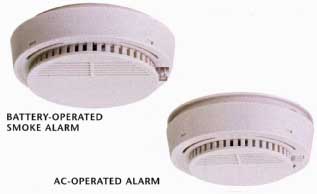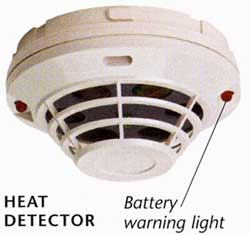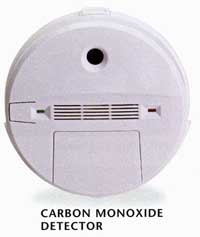The effects of fire can be devastating, and it's therefore necessary to take precautions to prevent fire in the home. Be sure to have adequate early warning systems, as well as effective escape routes should a fire occur. The first port of call for further advice on fire security should be your local fire department. They can provide help and advice relevant to your particular circumstances and can also advise on any fire safety stipulations that are part of your building regulations. This is essential when any major renovation or building work is being done. .
Alarms and Detectors
One of the most effective early warning systems is the smoke alarm. The terms “smoke alarm” and “smoke detector” have become the generic terms for these devices, although some react to heat rather than smoke.
Smoke alarms
The two main types of smoke alarms are battery-operated and AC-operated (see below). The former are easy to install and need regular battery checks. The alarm should have a warning system to indicate when power is low, and should be checked according to the manufacturer’s guidelines. Most are tested by pressing a button that sounds the alarm. At the very least, smoke detectors should be located on every floor of your home.

Above: battery-operated smoke alarm; ac-operated alarm
Heat detectors
Heat detectors are often slightly smaller in appearance compared to smoke detectors. They tend to be used in areas such as kitchens where a smoke detector may be too sensitive to cooking fumes.

Above: a HEAT DETECTOR. Note the battery warning light
Carbon monoxide alarms
These are now essential for homes. They look similar to smoke detectors, and are located close to fuel-burning appliances and sleeping areas. Carbon monoxide is an odorless gas emitted by fossil fuels during combustion. When appliances aren't vented correctly or are functioning incorrectly, carbon monoxide builds up in the home; high levels may be fatal. Alarms are normally located on walls between 3 ft and 4 ft (1 m and 1.5 m) above floor level.

Above: a carbon monoxide detector
AC Operation
AC-operated alarms are wired to a dedicated permanent supply that can't be accidentally turned off by the average user. They should also have battery backup in the event of a power outage. AC-operated systems are more common in newly built areas. All electrical safety guidelines must be followed before installing AC-operated systems.
Installing a Battery-Operated Alarm

A. Mark attachment points on ceiling surface. Ideally, screw into a ceiling joist; use the wall plugs and fasteners that are supplied.
B. Use pilot hole fasteners if screwing directly into joist, or use cavity wall plugs if screwing into drywall.
C. Screw plate into position, ensuring that it's secure.

D. Put the battery into the alarm, checking the connection carefully.
E. Close the hinged alarm casing.
F. Press the test button on the alarm to check that it's working.